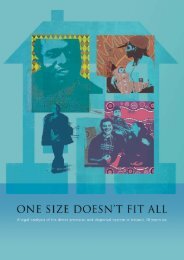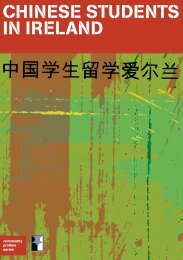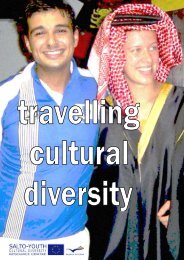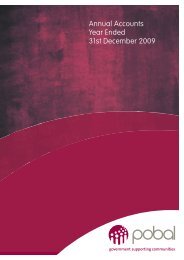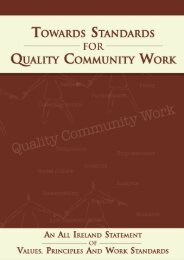Intercultural Education in the Post-Primary School - National Council ...
Intercultural Education in the Post-Primary School - National Council ...
Intercultural Education in the Post-Primary School - National Council ...
Create successful ePaper yourself
Turn your PDF publications into a flip-book with our unique Google optimized e-Paper software.
UN International Convention on <strong>the</strong>Elim<strong>in</strong>ation of All Forms of RacialDiscrim<strong>in</strong>ationArticle 1 – "racial discrim<strong>in</strong>ation" shallmean any dist<strong>in</strong>ction, exclusion, restrictionor preference based on race, colour,descent, or national or ethnic orig<strong>in</strong> whichhas <strong>the</strong> purpose or effect of nullify<strong>in</strong>g orimpair<strong>in</strong>g <strong>the</strong> recognition, enjoyment orexercise, on an equal foot<strong>in</strong>g, of humanrights and fundamental freedoms <strong>in</strong> <strong>the</strong>political, economic, social, cultural or anyo<strong>the</strong>r field of public life.The term ‘race’ appears <strong>in</strong> <strong>in</strong>vertedcommas each time it is used here (except <strong>in</strong>quotes) because scientific research has nowmade clear that, although <strong>the</strong> term iswidely used to describe groups of peoplewho are thought of as biologicallyseparate, <strong>the</strong>re is, <strong>in</strong> fact, no genetic oro<strong>the</strong>r scientific basis underly<strong>in</strong>g <strong>the</strong> term.Racism is one of a number of forms ofdiscrim<strong>in</strong>ation that exist <strong>in</strong> contemporarysocieties. O<strong>the</strong>rs <strong>in</strong>clude sexism, ageism anddiscrim<strong>in</strong>ation on <strong>the</strong> basis of a disability.All <strong>in</strong>volve rules, practices, attitudes andbeliefs which have <strong>the</strong> effect of deny<strong>in</strong>g orimpair<strong>in</strong>g someone’s access to <strong>the</strong> samebasic rights and freedoms as everyone else.Despite <strong>the</strong>ir similarities as forms ofdiscrim<strong>in</strong>ation, racism is sometimes wronglyperceived as be<strong>in</strong>g worse than o<strong>the</strong>r formsof discrim<strong>in</strong>ation, perhaps because it isoften associated <strong>in</strong> people’s m<strong>in</strong>ds withviolence, genocide or ‘hate crime’. The termracism, used properly, has much widerimplications than a narrow focus on ‘racial’hatred or violence would suggest. Itencompasses a range of attitudes or beliefson one hand and practices or rules on <strong>the</strong>o<strong>the</strong>r. This means that <strong>the</strong> term ‘racism’actually <strong>in</strong>cludes some th<strong>in</strong>gs that may nothave appeared as such to many people at afirst glance.• An attitude or belief is racist if it impliesthat some groups are superior or <strong>in</strong>feriorto o<strong>the</strong>rs based on <strong>the</strong>ir ‘race’, colour,descent, or national or ethnic orig<strong>in</strong>.This might <strong>in</strong>clude <strong>the</strong> belief that certa<strong>in</strong>groups (for example, Traveller, Asian orMiddle Eastern cultures) are moreprimitive or conta<strong>in</strong> less <strong>in</strong>tr<strong>in</strong>sic valuethan o<strong>the</strong>rs.• A racist practice or rule is one thatdist<strong>in</strong>guishes, excludes, restricts or givesrise to a preference based on ‘race’,colour, descent, or national or ethnicorig<strong>in</strong>. Racist practices and rules make itmore difficult for members of somegroups to atta<strong>in</strong> <strong>the</strong> human rights, accessto opportunities and life chances to which<strong>the</strong>y are entitled. Racist practices or rulesmay be practised by <strong>in</strong>dividuals (forexample through name-call<strong>in</strong>g, racistgraffiti, exclud<strong>in</strong>g people or us<strong>in</strong>gviolence aga<strong>in</strong>st <strong>the</strong>m), or by <strong>in</strong>stitutions(for example, though <strong>the</strong> application ofrules or regulations which do not makeallowance for cultural difference).These <strong>in</strong>terlock<strong>in</strong>g dimensions of racismare represented graphically <strong>in</strong> Figure 1.RACIST ATTITUDES OR BELIEFSStudies <strong>in</strong> Ireland from <strong>the</strong> 1980s onwardshave consistently found a significantm<strong>in</strong>ority who held hostile attitudes. In hisstudy of Prejudice and Tolerance <strong>in</strong> IrelandMicheál Mac Gréil found that <strong>in</strong> <strong>the</strong> late1980s <strong>the</strong>re was a significant m<strong>in</strong>ority ofIrish people who expressed racist views:• 16.7% of his national sample said thatblack people could never become asgood Irish people as o<strong>the</strong>rs because of<strong>the</strong>ir basic make up.• 10.8 % believed that black people were<strong>in</strong>ferior to white people.6<strong>Intercultural</strong> <strong>Education</strong> <strong>in</strong> <strong>the</strong> <strong>Post</strong>-<strong>Primary</strong> <strong>School</strong>








